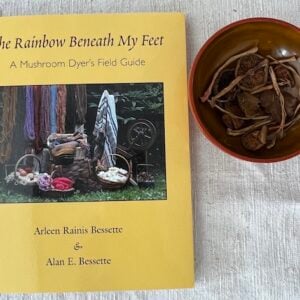We asked Julie Beeler, founder of the Mushroom Color Atlas, to dye some of our wool gauze with these mushrooms and she got lovely results! These recipes are courtesy of Julie Beeler’s experiments. Your results may differ.
Julie also made lake pigments with the exhausted dye baths and created watercolors with the reclaimed pigments.
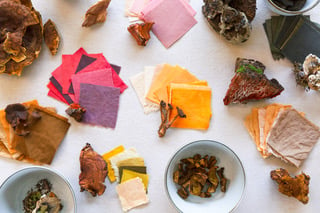
Cortinarius semisanguines (Surprise Web Cap)
The wool gauze is mordanted in iron at 2% of the weight of fiber (WOF), or in Aluminum Potassium Sulfate at 15% WOF + Cream of Tartar at 6% WOF.
Grind the dried mushrooms into a fine powder in a coffee grinder at a ratio of 1:2 (one part dried mushroom by weight to two parts fiber, or 50% WOF.) Note: the coffee grinder is used for dyestuffs only. Please wear a mask when grinding mushrooms or other dry ingredients.
Hydrate the mushroom powder in 1 liter (1 quart) water warmed to 115 degrees F( 46C). Add the powdered mushrooms to the water and stir well. Keep this mixture at 115 degrees F (46 C) for 1 hour, stirring occasionally.
To obtain the deep rose shade, Julie shifted the the pH of this mixture with soda ash to pH 9. She estimates she used a scant 1/4 teaspoon (approx. 1 gram) of soda ash.
Next, strain out the ground mushroom in a strainer lined with silk habotai or other straining fabric. The mushroom residue may be saved for eco printing or another extraction.
Wet out your mordanted wool fibers, then drop them into warm water and steep for 1 hour in warm water around 115 degrees F (46 C), stirring occasionally.
If you shift the dyebath to pH 4 with distilled vinegar, you will get coral and orange colors. Julie did not do this, but it makes a great second experiment!
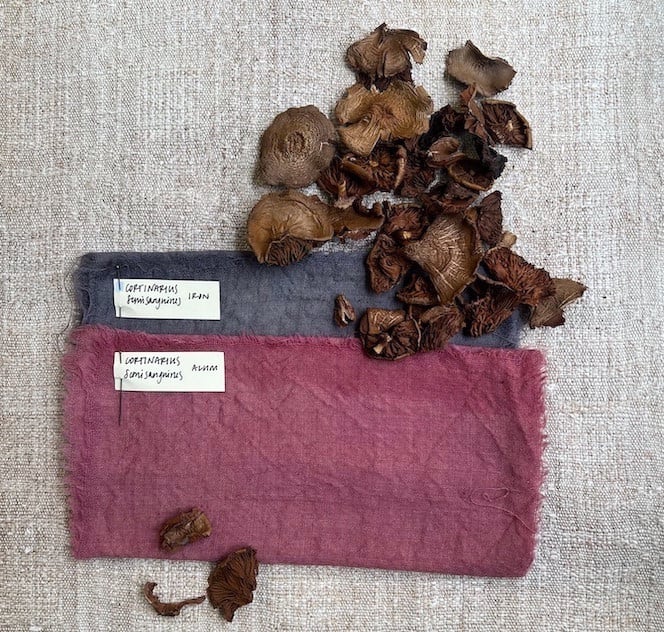
Cortinarius uliginosus (Marsh Webcap)
The wool gauze is mordanted in iron at 2% of the weight of fiber (WOF), or in Aluminum Potassium Sulfate at 15% WOF + Cream of Tartar at 6% WOF.
Grind the dried mushrooms into a fine powder in a coffee grinder at a ratio of 1:2 (one part dried mushroom by weight to two parts fiber, or 50% WOF.) Note: the coffee grinder is used for dyestuffs only. Please wear a mask when grinding mushrooms or other dry ingredients.
Hydrate the mushroom powder in 1 liter (1 quart) water warmed to 115 degrees F( 46C). Add the powdered mushrooms to the water and stir well. Keep this mixture at 115 degrees F (46 C) for 1 hour, stirring occasionally.
Next, strain out the ground mushroom in a strainer lined with silk habotai or other straining fabric. The mushroom residue may be saved for eco printing or another extraction.
Wet out your mordanted wool fibers, then drop them into warm water and steep for 1 hour in warm water around 115 degrees F (46 C), stirring occasionally.
Julie says that this mushroom made an orange shade in the bath, so she didn’t shift it with soda ash as she did with the other Cortinarius samples above, but we tried it with soda ash (approx. 1/4th teaspoon or 1 gram) and got a slightly darker, salmon shade.
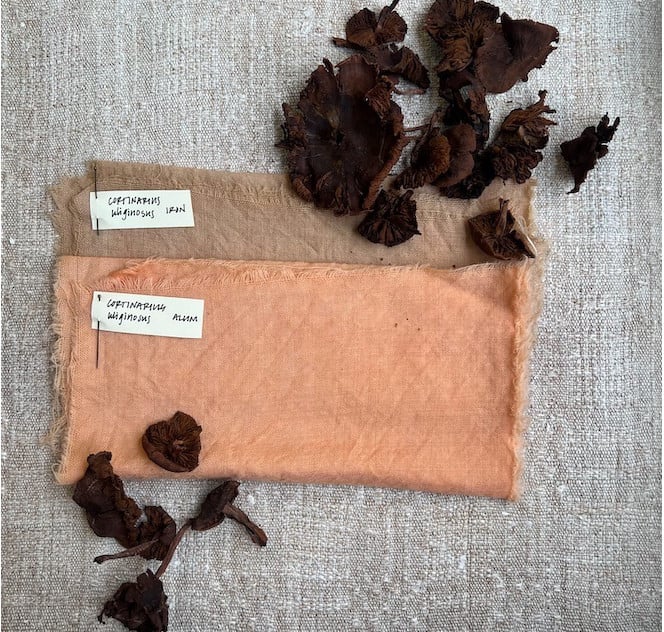
Tapinella atrotomentosa (Velvet Pax-foot)
The wool gauze is mordanted in iron at 2% of the weight of fiber (WOF), or in Aluminum Potassium Sulfate at 15% WOF + Cream of Tartar at 6% WOF.
Grind the dried mushrooms into a fine powder in a coffee grinder at a ratio of 1:1 (one part dried mushroom by weight to one part fiber, or 100% WOF.) Note: the coffee grinder is used for dyestuffs only. Please wear a mask when grinding mushrooms or other dry ingredients.
Hydrate the mushroom powder in 1 liter (1 quart) water warmed to 115 degrees F( 46C). Add the powdered mushrooms to the water and stir well. Keep this mixture at 115 degrees F (46 C) for 1 hour, stirring occasionally.
Next, strain out the ground mushroom in a strainer lined with silk habotai or other straining fabric. The mushroom residue may be saved for eco printing or another extraction.
Wet out your mordanted wool fibers, then drop them into warm water and steep for 1 hour in warm water around 115 degrees F (46 C), stirring occasionally.
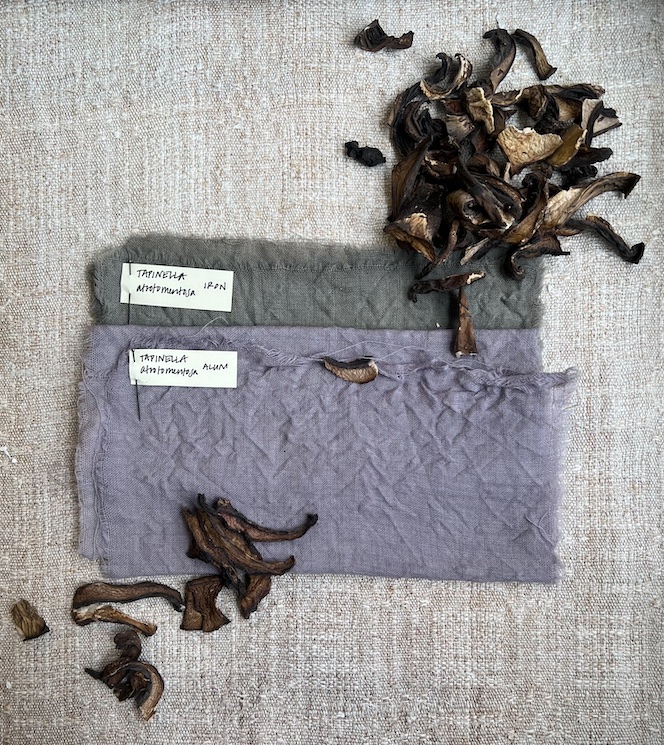
Hypomyces Lactifluorum (Lobster Mushroom)
Wool gauze is mordanted in Iron @ 2% WOF, or in Aluminum Potassium Sulfate @ 15% WOF + Cream of Tartar @6% WOF
Use the dried mushroom, finely ground in a coffee grinder at a ratio of 1:1 (one part dried mushroom by weight to 1 part fiber). If you can contain the ground up dried mushrooms in a muslin bag or a reusable tea bag, then you can easily remove them and dry them for future projects. Note that the coffee grinder is used for dyestuffs only. Please wear a mask when grinding mushrooms or other dry ingredients.
Hydrate the mushrooms in 1 liter (1 quart) water warmed to 115 degrees( 46C). The ground mushrooms or the mushroom bag are dropped into the warm water and stirred.
Let the mixture steep for 1 hour in warm water around 115 degrees (46 C), occasionally stirring.
Next, strain out ground mushrooms in a strainer lined with silk habotai or other straining fabric. The mushroom residue may be saved for eco printing or another extraction. If your mushrooms are in a muslin bag, simply remove the bag and dry the mushrooms for future use, or use them for a second extraction.
Wet out mordanted wool fiber was then dropped into the warm dye bath and steeped for 1 hour in warm water around 115 degrees, stirring occasionally.
The color may be a somewhat peachy orange if the dye bath is at pH 6. For redder shades, remove the fabric or yarn and add about 1/4th teaspoon soda ash, or a bit more, until the pH reaches 9. The color will shift to a rosier, sometimes nearly magenta hue.
Keep on low heat, raising the temperature slowly. Julie likes somewhere around 160F for 45 minutes to an hour. HIgher heat may cause a slight browning of the colors.
Remove and rinse, let air dry.
Julie also made lake pigments with the exhausted dye baths and created watercolors with the reclaimed pigments.


